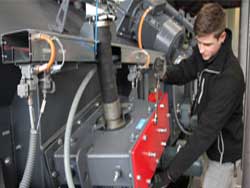
Shot Blasting has become one of the most effective and efficient tools for cleaning all sorts of surface areas from peening to layer preparation before repainting, polishing, removing grit, galvanizing, electroplating, welding, enameling, glass coating and rubberizing, etc. It is deemed a very cheap yet fast technique to be used in layer treatment.
Shot blasting is useful for myriad industries, including the aerospace, ship building, rubber and steel industries and what not because its endurance is high enough to treat material of any kind yet it gives a consistent and uniform result because the impact is high and forceful. This method is highly recommended to give wonderful surface preparation as traditional manual scrubbing and filing is much more slower and expensive. With just a compressed spray of media, we can have just excellent area formulation and then it could be what surface we intend to get. It can be from uniformly fine, rough to matte, peened or scraped metal exterior.
To take the best advantage of this method, it is deemed necessary that we first study the type of material we intend to prepare. Let’s talk about the real benefits of shot blasting over and above other techniques often used for surface preparation.

There are a few more reasons why the manufacturing industry prefers shot blasting for their surface preparation requirements.
The primary cleaning media in shot blasting uses small steel pellets or shots, many other types of shot blast materials are also used. But let’s take a look at the most commonly utilized shots:
Steel Shots – There are very tiny steel balls available in diameter from 1 to 6 mm which are fired from the nozzle at very high speed against the surface being prepared. The size of the balls and the material to be targeted must be proportionately determined to achieve the finishing. While smaller steel shots are used for polished surface, larger ones gives a rougher finish.
Steel Grit – Steel grits are somewhat angular and give a rough surface pattern. Blasting with steel grit is used generally for surfaces which require aggressive cleaning like removing dirt or rust or chemical contaminants from steel or any other metal.
Chilled Iron Grit – These too are angular, abrasive material used for general blast cleaning. Typically used for removing oxides and paints from ferrous castings and carbon steel, the method is quite harsh and not intended for softer metals like aluminium.
However, there are other media for softer preparation like corn cubs, walnut shells that have the most suited result in wood surface cleaning and polishing. Shot blasting is wholly dependent on the type of result we got to require.
